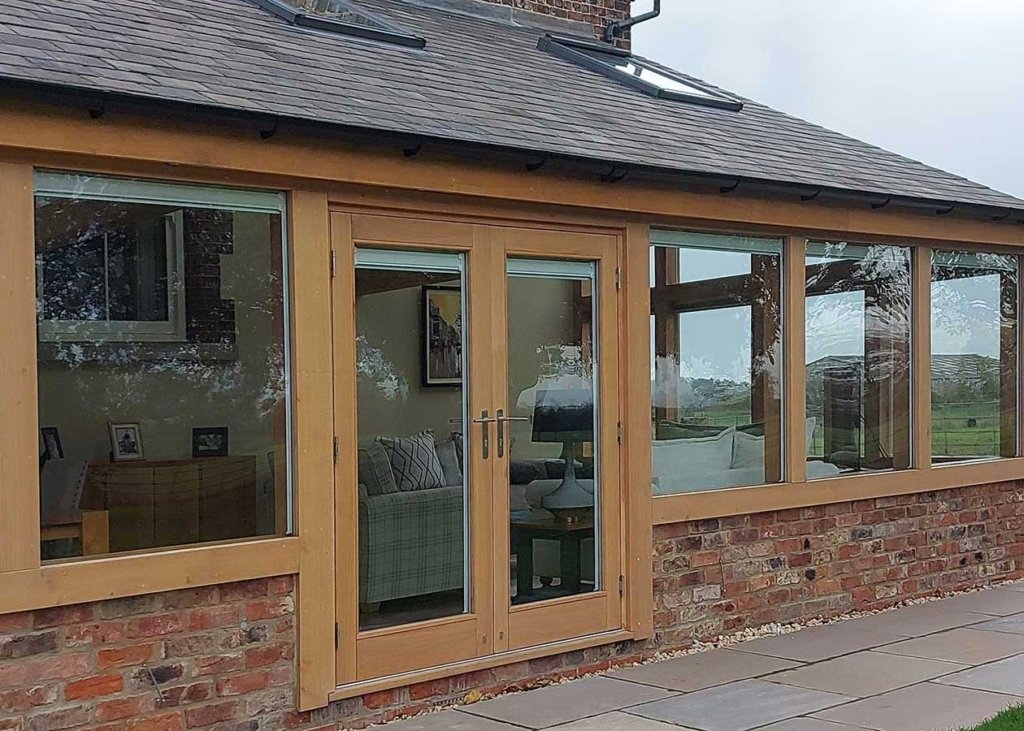
oakbydesign
01423 593 794



You’ve been considering adding an oak framed extension to your property and now you’re ready to get started.


Here we’ll cover all the considerations when it comes to constructing any oak extensions: from what types of oak are available, glazing options, building regulations, listed buildings and conservation areas.
All these details will help you make sure your new oak conservatory or oak orangery meets both aesthetic and legal requirements. We’ll also discuss other important factors such as heating and ventilation, party wall act and roof vents that need to be taken into account.
So if you want a extend your property with a beautiful new addition, that’s built with quality materials in a safe structure, read on for all the information you need!
If you’re looking to add a special touch to your home, consider the different types of wood available – seasoned, green, and air-dried. Each type offers unique benefits that must be weighed depending on your needs and preferences.
Timber grades are an important factor to consider when selecting wood for your property. The grade will determine the quality and strength of the wood. Additionally, wood treatments can help protect against rot and damp proofing is essential for any exterior project.
Ventilation design is also key in order for your extension to last a long time and remain healthy over time. It’s important that there is proper ventilation in place so that moisture doesn’t gather up in the timber which could lead to mould or other issues later down the line.
Structural calculations are also necessary to ensure that your extension is built safely according to regulations.
No matter what type of oak you choose, make sure it meets all safety requirements and fits within your budget before proceeding with construction plans. With careful consideration of these factors upfront, you can rest assured knowing that your build will stand the test of time while adding value and beauty to your home!
Glazing can be a tricky part of any home build, but it’s important to get it right for the best results. Choosing the right glazing is essential as it provides UV protection, noise reduction, thermal insulation, and energy efficiency. It also helps with condensation control and can add aesthetic appeal to your extension.
When choosing glazing, there are some important factors to consider. You need to make sure that the glass you choose meets all relevant Regulations. This will ensure that your extension is safe and secure.
You should also think about how much natural light you want in your oak conservatory or building and whether you need additional privacy or soundproofing. Finally, if there is a boundary near the conservatory, then double-glazing may not be an option. Single-glazed glass will provide more effective insulation in this situation.
It’s important to remember that planning permission and Regulations are two separate issues in construction. So, make sure you check both before beginning work on your house! The same applies to planning permission drawings and regulation drawings. The latter is more detailed and offer more information to a contractor when pricing for a job.
Regulations must be taken into consideration when constructing any oak framed extension, as they ensure the safety and security of the structure. When planning a conservatory extension, it is important to consider energy efficiency, window sizes, construction materials, soil conditions and obtain necessary permits.
Regulations also exist for adding glass extensions to listed buildings or in conservation areas where permission is needed before any work can begin. The Building Regulation legislation lays down minimum standards covering the design, construction and alteration of buildings ensuring all relevant health and safety regulations are met.
These regulations will vary depending on what type of extension you’re planning. It’s essential that your plans comply with current Building Regulations for fire safety measures, energy efficiency levels and ventilation requirements. In addition, it’s important that building works don’t interfere with existing sewers or require party wall agreements with neighbouring properties.
Before starting any foundation work on a new oak framed extension, you should have an understanding of ground conditions and subsoil to ensure stability, which could otherwise lead to structural damage. Having a good comprehension of these regulations can help make sure your project runs smoothly throughout the entire process so that you can complete your dream room without running into problems along the way.
Constructing conservatories on any listed building isn’t a joke – it’s an absolute nightmare! But with the right information and research, plus some heritage protection and stylish designs, you can add something beautiful to your home that will stand the test of time.
When you construct an oak framed extension on a listed building, there are certain things you need to consider. Firstly, you’ll need to abide by conservation laws and regulations when choosing your materials. It’s important to ensure that any architectural features are preserved during the construction process.
Secondly, you’ll also need to obtain Listed Buildings Consent before commencing work on the project. This consent should be obtained from your local authority prior to any alteration taking place.
Lastly, it’s essential that all alterations respect the character of the original property while also allowing for modern additions such as energy-efficient glazing or insulation.
Creating extensions must be in accordance with these principles will allow you to maintain the historical look of your property whilst still being able to enjoy its many benefits in terms of increased living space and improved energy efficiency.
With careful consideration and planning, it’s possible for those lucky enough to own a listed building to add something special without compromising their property’s unique identity.
Moving forward into Conservation Areas requires further due diligence; however, with patience and dedication, it’s possible for even those with limited knowledge about traditional homes law procedures can find success in this field too.
If you’re looking to add an oak conservatory to your home located in a conservation area, you’ll need to make sure you’ve applied for the necessary consent or permission beforehand. Local bylaws and regulations may determine what type of construction is allowed and how it can be modified to fit the needs of the specific area.
Climate change, historic preservation, visual impact, natural resources, and other considerations are taken into account when determining the suitability of a conservatory extension in a conservation area. Depending on the local council’s decision, approval is usually given if certain conditions are met such as design considerations that blend with existing surroundings or protocols that help protect nature and wildlife habitats.
When applying for consent or permission to build in an Area of Natural Outstanding Beauty (AONB), it’s important to consider any potential alterations that could affect nearby properties. Before submitting your application, you should check with neighbors whether they have objections due to increased noise levels or shading from your new conservatory extension. You must also consider any planning guidelines which apply specifically for AONBs such as protection of its scenic beauty, ground cover restrictions and limited use of space within designated areas.
It’s essential that environmental issues are taken into consideration when constructing oak framed extensions in a conservation area. This includes reducing energy consumption through sustainable materials such as air-dried oak frames and green oak frames which offer insulation benefits compared to traditional materials like brickwork or stone masonry.
As well as considering appropriate glazing options for your conservatory design; glass reflects heat away from inside during summer time while keeping it warm during winter time so less energy is consumed overall – helping conserve both energy and money!
When adding an oak building albeit an oak conservatory, orangery or garden room, there are other important considerations to take into account such as heating and ventilation, the Party Wall Act 1996, and even sewers. So, make sure you’ve got all your bases covered!
It’s essential that you look at insulation options for your conservatory too – both thermal and acoustic. The roof vents should also be taken into account when planning the build, as these will provide the necessary airflow for preventing overheating in summer months.
Considering foundation work is also crucial in order for your conservatory to remain stable. Understanding what type of subsoil is located beneath your garden before construction begins can save time, hassle, and money further down the line.
The Party Wall Act 1996 also needs to be taken into account when building near neighbouring property. This legislation regulates activities between two adjoining properties which include building extensions or carrying out excavations close by – so it’s well worth familiarising yourself with this act before beginning any works.
In addition, heating solutions need careful consideration. Underfloor heating provides an efficient heating solution, although it often requires specialist installation due to its complexity. Furthermore, radiators or direct electric heaters can provide a more cost-effective way of keeping warm during colder periods but may not be as energy efficient overall.
No matter what heating solutions you decide, it pays to do some thorough research beforehand in order to ensure that all aspects of energy efficiency have been considered thoroughly – from insulation levels through to air tightness ratings – all of which contribute towards a comfortable living environment throughout the year. If you decide on creating a kitchen, then you will need extra services, for example, more electrical sockets, water and drainage. A kitchen may also benefit from not having a side view of the appliances.
Adding an oak conservatory or conversions to your home can be a great way to add value and style. With the right considerations, you can ensure you will be successful.
Consider the types of oak you choose, glazing options, building regulations, listed buildings, and conservation areas before starting.
Don’t forget other important details such as heating and ventilation, party wall act, and roof vents too.
With these tips in mind, you’ll have all the knowledge you need to make sure your room is a stunning success!
Oak framed rooms can have a frame design that is a custom built. The custom build will allow your personality and lifestyle to be incorporated into the design.
Should you require impartial and free advice, albeit price, lead times, construction or technical, please give us a call on 01423 593794. We have a beautiful showroom if you are in the area (near York North Yorkshire) and an appointment is not always necessary. We can pop the kettle on and would be happy to chat through any ideas, sketches or plans you have. We offer a friendly and professional service and understand most common areas of uncertainty allowing us to reassure you on how a project with a view can be achieved.
Telephone: 01423 593 794
Locksley Park
Blind Lane
Tockwith
YORK YO26 7QJ
Opening Times:
Mon to Fri - 9.00am to 5.00pm
Bank Holidays - Closed
Christmas 2025- TBC
Oak By Design is the trading name of:
Oak By Design Ltd.
Reg Number: 04384416
VAT Number: 664 8012 33